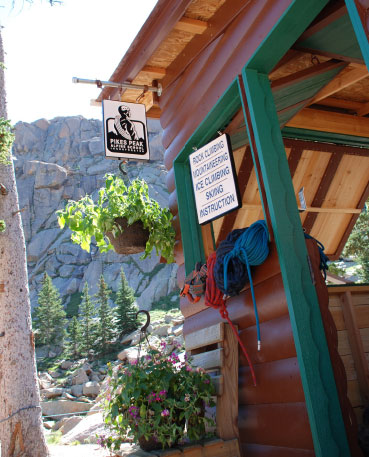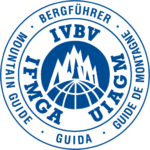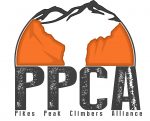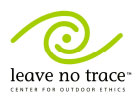AMGA/IFMGA Certified Guides and Instructors
Pikes Peak Alpine School has taught climbers, mountaineers and skiers and offered guidance in the mountains since 1989. We are your ROCK, SNOW, and ICE guide service on Pikes Peak.
Who we are?
Pikes Peak Alpine School is a mountain school and guide service centered in the Pikes Peak region. We also guide throughout Colorado, the North Cascades, Alaska and the Alps. The School has been teaching and offering guidance to mountaineers, climbers, and snow riders since 1989. We guide year-round; ROCK, SNOW, and ICE on Pikes Peak and beyond.
We love rock, snow, and ice. Having the ability to adjust to the current conditions of the terrain allows us to teach, guide, and play year round. Some of our favorite ways to experience the unwavering beauty of the Springs is to climb the technical routes and hike to the summit of our backyard 14er, Pikes Peak. We offer single or multi-pitch climbing on rock in the warmer months and ice climbing in the winter months. Guests can take one of our multi-day mountaineering courses preparing them for climbs on glaciated terrain around the world. Avalanche education is among our core programs at Pikes Peak Alpine School. For a skier/snowboarder looking to get away from the resorts and step out into the backcountry for the first time or a hiker working on the 14ers and looking to include a few winter ascents, avalanche training is a must. Regardless the season, we get out and want you to join us!
Our mission at Pikes Peak Alpine School is to provide exceptional guidance and education for climbers, mountaineers, skiers, and splitboarders. Our passion is extended to all ages and all levels of experience for the enjoyment and safety of the outdoor community.
PIKES PEAK ALPINE SCHOOL
Established 1989

Why Choose Our Guides?
Smaller ratios: Most of the climbs and outings we guide are 2:1 guest to guide ratios. This means more hands on for participants on courses and bigger objectives for guided climbs. This also means the course or climb can be customized. We aim to truly know our guests by the end of the day or the trip, not just a name in the crowd.
Professional guides: The PPAS guides encompass the three qualities that make up a great guide. Our guides are experienced, qualified and passionate about what they do. We understand the mountains have an infinite amount of knowledge to be acquired. Our guides are passionate to continue to improve their own personal skills, whether it’s spending time together in the mountains or crags on off-days or professional development through the American Mountain Guides Association. We hold ourselves to a high standard of expertise and knowledge, making Pikes Peak Alpine School the leading authorities of current affairs in the Front Range. This passion has evolved over years of experience making us who we are. It fuels our enthusiasm to adventure and educate new and experienced climbers alike.
AMGA/IFMGA Training and Certification: Because some climbing areas (including Garden of the Gods) don’t require climbing guides to have any formal training, hiring a guide can be “climber beware”. As well as in-house training all of our guides have subjected themselves to the examination and assessment from the American Mountain Guides Association (AMGA). The AMGA is the only internationally recognized third party standard for guide training and certification. Our guides have higher level of training and experience than any other company in Colorado Springs. Each of our guides have taken at minimum, the AMGA Single Pitch Instructor. Some are full IFMGA Mountain Guides, a ten year training and exam process. To better understand the AMGA training investment, see Our Guides page and the AMGA education flowchart on that page.
We Leave No Trace
With the rise in popularity of backpacking and climbing, the mountains around the world are being visited by ever increasing numbers of people. We are drawn to the mountains for their beauty, purity, remoteness, ruggedness, and the unique challenges they present. The mountains are our home, and it can sometimes be challenging to Leave No Trace and maintain the natural beauty of the wilderness areas we explore. At PPAS we take Leave No Trace ethics and practices very seriously. The mountains are our home and we are unwilling to sacrifice their preservation for human objectives.
We believe that given the proper information most people will do all they can to help protect and maintain the environment. As guides, we spend time teaching the environmentally appropriate Leave No Trace principles and practices. There is nothing more beautiful than working hard to get high into the mountains, come upon a pristine campsite, witness incredible views and have the feeling that no one has been there before. And there is nothing more disheartening than working hard to climb a mountain, reaching a site and encountering trash, food waste and/or toilet paper. Please read the seven LNT principles below and feel free to call the office if you have any questions about what you can do to plan ahead and prepare.
Thanks for taking the time to read this information. We look forward to climbing with you.
1) PLAN AHEAD AND PREPARE
•Define your trip itinerary and objectives by researching relevant information including: route conditions, avalanche danger, weather forecasts, and local permits and regulations.
•Prepare for extreme weather, hazards, emergencies and self-rescue.
•Determine the strategy for your team’s food and fuel consumption, and for waste disposal.
•Choose an appropriate route that suits your team¹s size, ability and experience. Leave a copy of your itinerary with family or friends.
•Repackage your food into reusable containers or bags.
•Carry and know how to use a map, compass, altimeter, route markers and, possibly, a global positioning system unit.
2) TRAVEL AND CAMP ON SAFE, DURABLE SURFACES
On Trail
•Focus your activities on durable surfaces, including: established trails, deep snow, rock or inorganic soil. Avoid vegetation, thin snow cover and organic soils.
•Establish an appropriate route up the mountain, taking into consideration the team’s safety and Leave No Trace principles. Plan your route with the idea that others will follow.
•Whenever possible and safe, remove route markers during your descent.
At Camp
•In high-use areas, use established campsites. In pristine areas, minimize your impacts by breaking down constructed snow walls and wind breaks.
•Use man-made tent anchors (ice screws, axes, poles, etc.) whenever possible. Replace any rocks or other natural anchors where found.
3) DISPOSE OF WASTE PROPERLY
•Pack It In, Pack It Out. Pack out everything you carry with you including garbage, trash, and extra fuel. Trash left at altitude or in crevasses does not biodegrade. Whenever possible, remove others’ discarded waste from the mountain.
•In high use areas, use established restroom facilities. Otherwise, pack out solid human waste via “blue bags” or other techniques. If packing out all solid human waste is not possible due to trip duration, refer to local protocols on how to dispose of human waste.
•Designate a “clean snow” area (up slope from camp) to serve as your water source. Focus your activities and waste disposal sites away from this area.
•Consolidate liquid human waste in a designated urinal down slope from camp and away from the designated water (snow) source. Consider using a “pee bottle” in camp to facilitate disposal. When traveling, step off the trail to urinate, so others won’t have to hike through yellow snow.
•Dispose of gray water (dishwater) in a designated sump hole down slope from camp. Strain the dishwater and pack out all leftover solids.
4) LEAVE WHAT YOU FIND
•Leave all rocks, plants, animals and historical or cultural artifacts as you find them.
5) MINIMIZE CAMPFIRE IMPACTS
•Always carry a lightweight camp stove. Adequate wood is generally unavailable on mountaineering expeditions, making fires infeasible and inappropriate.
6) RESPECT WILDLIFE
•Observe wildlife from a distance. Do not follow or approach them.
•Never feed wildlife or leave food behind to be eaten.
•Protect wildlife and your food by storing rations and trash securely.
•Anticipate changing weather conditions by marking your cache.
7) BE CONSIDERATE OF OTHER VISITORS
•Communicate and cooperate with other teams.
•Yield to uphill climbers by stepping off the route onto a durable surface.
•Avoid unnecessarily clustering campsites whenever possible.
•Let nature’s sounds prevail. Keep loud voices and noises to a minimum.
•Take rest breaks off the route, away from other campsites, and on a durable surfaces.











